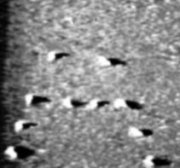Gangsters break someone’s arm to deliver a message, leaving a powerful impression that may never go away. Now, a team of Chinese and U.S. scientists finds that roughing up organic molecules also can leave an enduring, though small, memory. In this case, however, some reverse strong-arming can quickly wipe out that memory.


Today’s CD-ROMs squeeze 100 million bits into each square centimeter of recording surface. In the Feb. 21 Physical Review Letters, Hongjun Gao of the Chinese Academy of Sciences in Beijing and his colleagues report writing and erasing data in minute dots. These dots could potentially be crammed together to encode information a million times more densely than CD-ROMs do and top even hard disks by a factor of nearly 100,000. However, the lab accomplishment remains far from commercial realization, the experimenters caution.
“This is very attractive work. It probably has applications as an organic [chemical]-based memory,” comments James M. Tour of Rice University in Houston. Gao, currently a guest scientist at Oak Ridge (Tenn.) National Laboratory, and his coworkers in China have spent years investigating substances that have potential for high-density data storage and molecular-scale electronics. In particular, the researchers have considered a class of carbonbased materials, called conjugated organic compounds, that show unusual electronic properties.
For many of the compounds, the molecules have positively and negatively charged ends. This polarization makes them pushovers for electric fields, which exert forces on the charged regions. Testing two such compounds, 3-nitrobenzal malononitrile and 1,4-phenylenediamine, the researchers found that a blend of the plasticky substances can form a thin, electrically resistive coating on graphite or glass plates. By applying positive voltage pulses with the probe of a scanning tunneling microscope, the Chinese team created tiny spots in the film with only a ten-thousandth the electrical resistivity of the rest of the film. Each spot was a nanometer or less in diameter.
The researchers found that the spots hold their low resistivity until subjected to negative voltage pulses, which restore them to the high-resistivity state. Not knowing what characteristic of the material allows the resistivity to change, the Chinese researchers teamed with scientists at the Oak Ridge lab and the University of Chicago.
In a series of experiments, the collaborators discovered that the applied positive voltage transforms a patch of organic material into a disorderly, or amorphous, arrangement, which is much less resistive than the ordered crystalline film.
The voltage pulse wrestles the polarized molecules into their new configuration. “They get torqued, twisted, and all disoriented,” says Karl W. Sohlberg of Oak Ridge. A pulse of opposite polarity realigns the molecules with the lattice.
The number of molecules affected must be very small, the researchers argue, since each spot roughly covers one unit of the crystal structure. “If you’re talking about reorienting individual molecules, we are certainly very close to that limit,” Sohlberg says.







